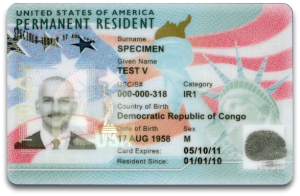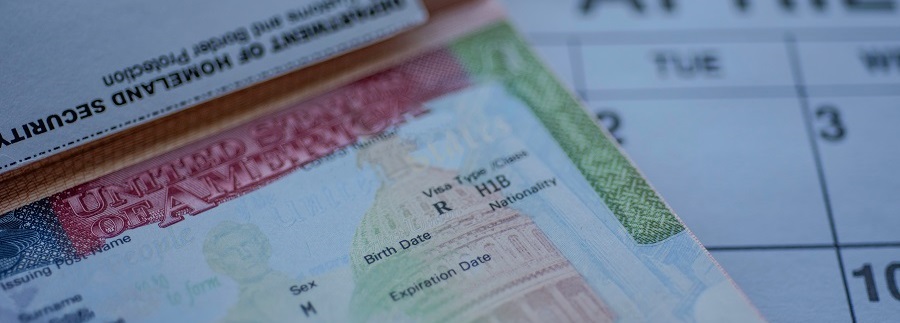
By itself, the H-1B visa does not provide a direct path to permanent resident status (green card) in the United States. In other words, something else has to happen in order for an H-1B foreign national to become eligible for a green card. While generally we think of the employment-based path for H-1B visa holders, there are various ways through the H-1B green card process.
Benefits of the H-1B Visa
The H-1B is extraordinarily popular. That's because it provides qualifying foreign nationals a path to well-paid employment in the United States with the privilege of applying a green card when it becomes available. In other words, it's a dual intent visa.
Long-Term Employment Privileges
The H-1B is a nonimmigrant visa. Essentially, that means it’s a temporary means to stay in the United States. A foreign national working in the U.S. on an H-1B visa may generally stay for a period of up to six years. Upon reaching that six-year mark, the H-1B visa holder generally must depart the United States or have an employer that wants to sponsor him or for permanent residence (green card).
H-1B is a Dual Intent Visa
Foreign nationals in H-1B nonimmigrant status can be the beneficiary of an immigrant visa petition, apply for adjustment of status, or take other steps toward permanent resident status without affecting their status. This is known as a dual intent visa and has been recognized in immigration law since passage of the Immigration Act of 1990. Most nonimmigrant visitors to the United States may not arrive with the intent to stay permanently. Dual intent means that the visitor may stay temporarily but also seek permanent residence. This is a special benefit.
Employment-Based Path to a Green Card
Most H-1B workers who become permanent residents find a path to the green card via employment. As the name suggests, employment-based green cards are initiated by an American employer that is willing to sponsor an employee for permanent resident status. It costs money to sponsor an employee through the process. Therefore, these coveted roles are typically for well-educated employees with skill sets not in strong supply through the domestic workforce. The employment-based path to a green card is a rigorous process with three major steps:
PERM Labor Certification
Initially, the employer must clear the way to hire a foreign employee by filing a PERM application. The PERM – Program Electronic Review Management — system is the process for managing this paperwork with the American government. In short, the PERM process helps ensure that:
- The current pool of U.S. workers (U.S. citizens, permanent residents, and other specially authorized aliens) has no one that is qualified, available and willing to perform the position; and
- The salary offered is reasonable in the current labor market (prevailing wage determination).
PERM labor certification protects U.S. workers but also protects the H-1B green card prospect from artificially lowered wages.
File Form I-140
Again, it's the employer that must advance the H-1B green card process. The employer must file Form I-140, Immigrant Petition for Alien Workers, to request an employment-based immigrant visa. Upon successfully filing the I-140 petition, the beneficiary gets a "priority date." In many cases there is a long wait for an H-1B green card. The priority date marks the beneficiary's "place in line."
It's imperative the H-1B visa holder maintain lawful immigration status. H-1B workers are able to request an extension of their visa status in one-year increments if their labor certification or I-140 petition was filed a year prior to the beginning of their exemption from the normal 6-year limit.
File Form I-485
Finally, once Form I-140 is approved and an immigrant visa is available, the H-1B worker may adjust status to permanent resident. He or she must continue to be inside the United States and in a valid immigration status. The intending can immigrant adjusts status by filing Form I-485, Application to Register Permanent Residence or Adjust Status. While the adjustment of status application is technically filed by the foreign national, often the employer's legal counsel will continue to handle this part of the H-1B green card process.
The adjustment of status process can take several months, sometimes more than a year. Upon approval, USCIS grants the foreign national permanent resident status and issues him or her a green card.

Types of Employment-Based Categories
The employment-based green card categories include EB-1 through EB-5. The number indicates the preference for a category. Although there are EB-4 and EB-5 categories, but these are actually very different and outside the scope of this article.
EB-1: Employment-Based First Preference Immigrant Visa
The EB-1 category includes three subcategories of priority workers:
- Persons of Extraordinary Ability: To meet the eligibility criteria, the green card applicant must prepare extensive documentation proving continuous national or international acclaim and recognitions in the subject field (of science, art, education, business, or athletics), but the applicant doesn’t need to have a specific job offer.
- Outstanding Professors and Researchers: Applicants must have at least three years of experience in teaching or research and international recognition. The prospective employer must provide a job offer and sign the I-140 petition, but the employer does not need the PERM labor certification.
- Multinational Executives and Managers: Applicants must have have been employed for at least one of three preceding years by a U.S. parent, subsidiary, branch, or affiliate of a foreign corporation. The potential employer must provide a job offer and file a petition with USCIS. Labor certification is not required.
EB-1 Requirements: To demonstrate you have sustained national or international acclaim and that your achievements have been recognized in your field of expertise, you must either include evidence of a one-time achievement (major internationally-recognized award) or three of the 10 listed criteria below (or comparable evidence if any of the criteria do not readily apply):
- Evidence of receipt of lesser nationally or internationally recognized prizes or awards for excellence
- Evidence of your membership in associations in the field which demand outstanding achievement of their members
- Evidence of published material about you in professional or major trade publications or other major media
- Evidence that you have been asked to judge the work of others, either individually or on a panel
- Evidence of your original scientific, scholarly, artistic, athletic, or business-related contributions of major significance to the field
- Evidence of your authorship of scholarly articles in professional or major trade publications or other major media
- Evidence that your work has been displayed at artistic exhibitions or showcases
- Evidence of your performance of a leading or critical role in distinguished organizations
- Evidence that you command a high salary or other significantly high remuneration in relation to others in the field
- Evidence of your commercial successes in the performing arts
EB-2: Employment-Based Second Preference Immigrant Visa
Every applicant in the EB-2 category must have a labor certification approved by the Department of Labor, a job offer, and the prospective U.S. employer who will file an immigrant petition (Form I-140) on behalf of the applicant. The EB-2 subcategories include:
- Advanced Degree: To meet the eligibility criteria, the green card applicant must be a professional who obtained an advanced degree or a baccalaureate degree plus at least five years of progressive experience in the profession.
- Exceptional Ability: Qualifying applicants include individuals with exceptional ability in the sciences, arts, or business significantly above that ordinarily encountered within the field.
EB-2 Requirements: To demonstrate you qualify as a second preference employment-based applicant, you must submit:
- Official academic record showing that you have a degree, diploma, certificate, or similar award from a college, university, school, or other institution of learning relating to your area of exceptional ability
- Letters from current or former employers documenting at least 10 years of full-time experience in your occupation
- A license to practice your profession or certification for your profession or occupation
- Evidence that you have commanded a salary or other remuneration for services that demonstrates your exceptional ability
- Membership in a professional association(s)
- Recognition for your achievements and significant contributions to your industry or field by your peers, government entities, professional or business organizations
- Other comparable evidence of eligibility is also acceptable.
Certain foreign nationals in the EB-2 preference category may qualify for a National Interest Waiver (NIW). The beneficiary of a NIW is exempt from the PERM (labor cert) requirement. What's more, an NIW beneficiary may self-petition and does not need job offer.
To qualify for the waiver, the applicant’s work must benefit the “national interests” of the United States. The USCIS Administrative Appeals Unit has suggested one or more of the following factors be considered whether the foreigner’s work meets this standard:
- Enhancing the U.S. economy;
- Improving working conditions and wages of U.S. workers;
- Improving U.S. education and training programs;
- Making health care better in the U.S.;
- Improving the environment in the U.S.;
- Providing more affordable housing in the U.S.; or
- Obtaining a request from an interested U.S. Government Agency.
EB-3: Employment-Based Third Preference Immigrant Visa
Every applicant in the EB-3 category must generally have a labor certification, a job offer, and the prospective U.S. employer who will file an immigrant petition (Form I-140) on behalf of the applicant. The EB-3 subcategories include:
- Skilled Workers: To be eligible, the green card applicant must be able to demonstrate that he or she possesses at least two years of job experience, education, or training that meets the job requirements specified on the labor certification.
- Professionals: Qualifying applicants include individuals with U.S. baccalaureate or foreign equivalent degree that is appropriate for entering the profession.
- Unskilled Workers (Other Workers): Qualifying applicants must demonstrate the ability to perform unskilled labor (requiring less than two years of training or experience) for a job that is non-seasonal in nature.
Please review the USCIS descriptions for additional requirements.

Request Job Portability
In certain cases, the H-1B green card applicant may switch jobs before USCIS grants permanent residence. This may be for a variety of reasons. The job may no longer be available or the petitioning company may have gone out of business. The H-1B visa holder may have also found a better job opportunity. The INA § 204(j) accommodates job portability for individuals who have:
- Properly filed a Form I-485 based on an approved or pending Form I-140 that names them as the principal beneficiary;
- A Form I-485 that has been pending with USCIS for 180 days or more since the receipt date; and
- Received one of the following:
- A new, permanent job offer from a U.S. employer that is in the same or similar occupational classification as the job offered in the original Form I-140, and the applicant would like to request that USCIS use the new job offer when making a decision on Form I-485; or
- An RFE or a NOID from USCIS regarding the applicant’s pending Form I-485 that asks for confirmation that the job offered to the applicant in the Form I-140 or a previously filed Supplement J is still available;
- A NOID from USCIS regarding the applicant’s Form I-485 because the petitioner has withdrawn the Form I-140 filed, or the petitioner of the applicant’s Form I-140 has gone out of business.
The adjustment applicant may change jobs and still adjust status as long as the new job is in the same or a similar occupation. Before approving the I-485 application for adjustment of status, USCIS must receive a request for job portability which includes:
- Form I-485 Supplement J, Confirmation of Bona Fide Job Offer or Request for Job Portability;
- Employment verification letter to confirm that an offer of permanent employment exists; and
- Any other documentation needed to establish eligibility for portability.
The letter must contain a description of the job as well as the salary. The USCIS will use this letter to determine whether the job meets the same or similar occupation requirement.
H-1B Green Card Timeline
The time it takes to go from H-1B to green card can vary significantly based on the type of employment visa and your country of origin. As mentioned above, the process actually begins when the employer starts the PERM labor certification and ends when USCIS grants permanent residence. There are generally annual limits of different types of immigrant visas, and wait times can be lengthened by per-country limits.
The full employment-based H-1B green card timeline can range anywhere from 10 months to several years. Only applicants within unlimited visa categories visas can realistically adjust status within a year. Those with annual limits on their visa category will have to monitor the visa bulletin to determine when a priority date becomes current.
RECOMMENDED: Form I-485 Processing Time
H-1B Marriage to a U.S. Citizen
It isn't uncommon for H-1B visa holders to find another path to a green card while working in the United States. One of those ways is through marriage to a U.S. citizen. In this case, the H-1B nonimmigrant does not need an employer to sponsor the green card. That’s because his or her spouse may petition through the family-based system. The spouse of a U.S. citizen is in the immediate relative category, and there are significant benefits to this category. If the H-1B nonimmigrant has overstayed a visa or accepted any unauthorized employment, the grounds of inadmissibility do not apply to immediate relatives who adjust status. Those waiting through the H-1B green process may have lengthy wait times that last several years. The immediate relative category can often adjust status within approximately one year.
Instead of filing Form I-485 on the basis of an I-140 petition, the H-1B visa holder may concurrently file the I-485 application with the family-based petition (Form I-130, Petition for Alien Relative). Learn more about family-based adjustment of status.
The H-1B may also obtain permanent residence through marriage to another green card holder. However, unless an immigrant visa is immediately available, he or she will not be able to adjust status. Instead, the foreign national may need to use consular processing if unable to maintain H-1B status.
Other Paths through the H-1B Green Card Process
In addition to the marriage-based path, there are other family categories which could make an H-1B nonimmigrant eligible for permanent resident status in the United States. For a complete list of possible relationships, view the immediate relative and family preference categories.
In some cases, H-1B nonimmigrants have also been able to adjust status through the green card lottery, asylum status or U visa.
About CitizenPath
CitizenPath provides simple, affordable, step-by-step guidance through USCIS immigration applications. Individuals, attorneys and non-profits use the service on desktop or mobile device to prepare immigration forms accurately, avoiding costly delays. CitizenPath allows users to try the service for free and provides a 100% money-back guarantee that USCIS will approve the application or petition. We provide support for the Adjustment of Status Application (Form I-485), Employment Authorization Application (Form I-765), and several other immigration services.
Want more immigration tips and how-to information for your family?
Sign up for CitizenPath’s FREE immigration newsletter and
SAVE 10%
on our immigration services



